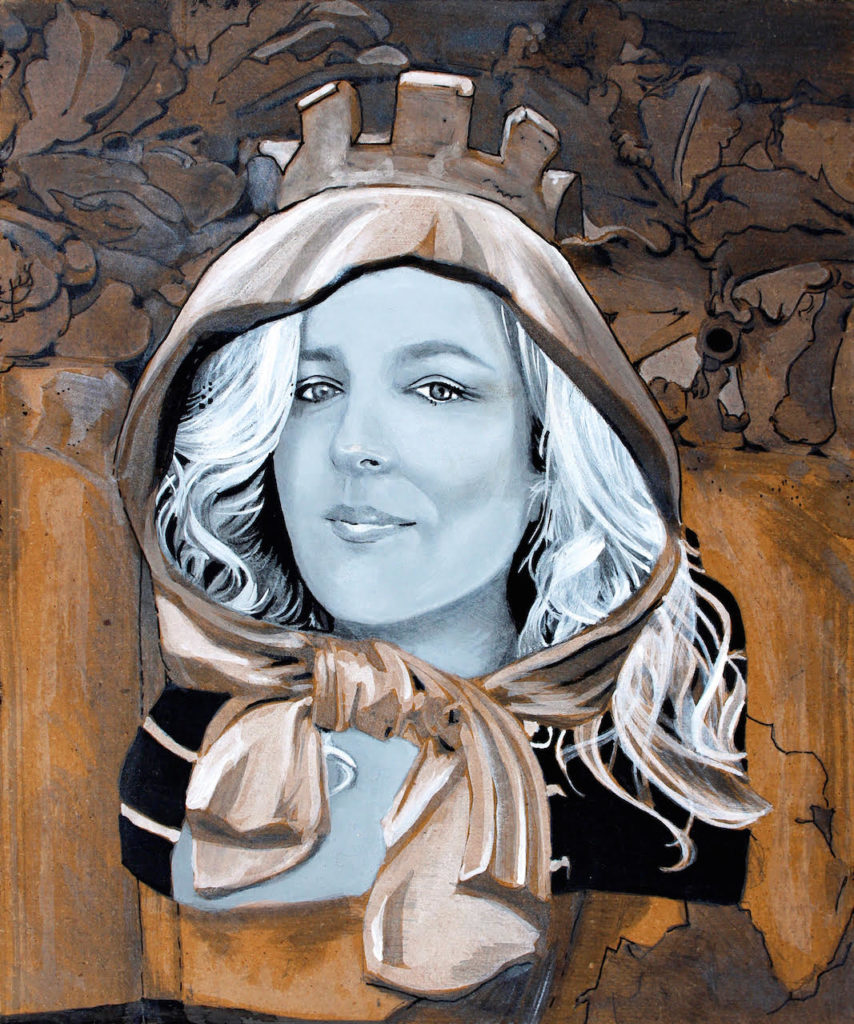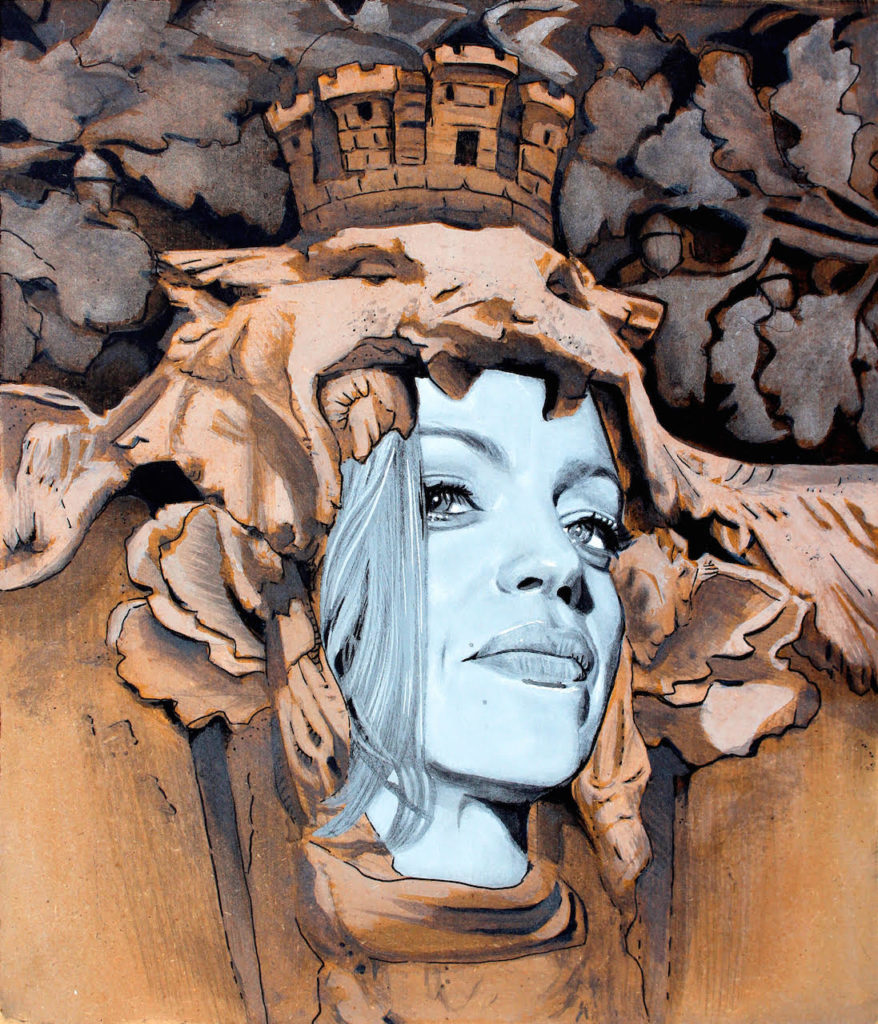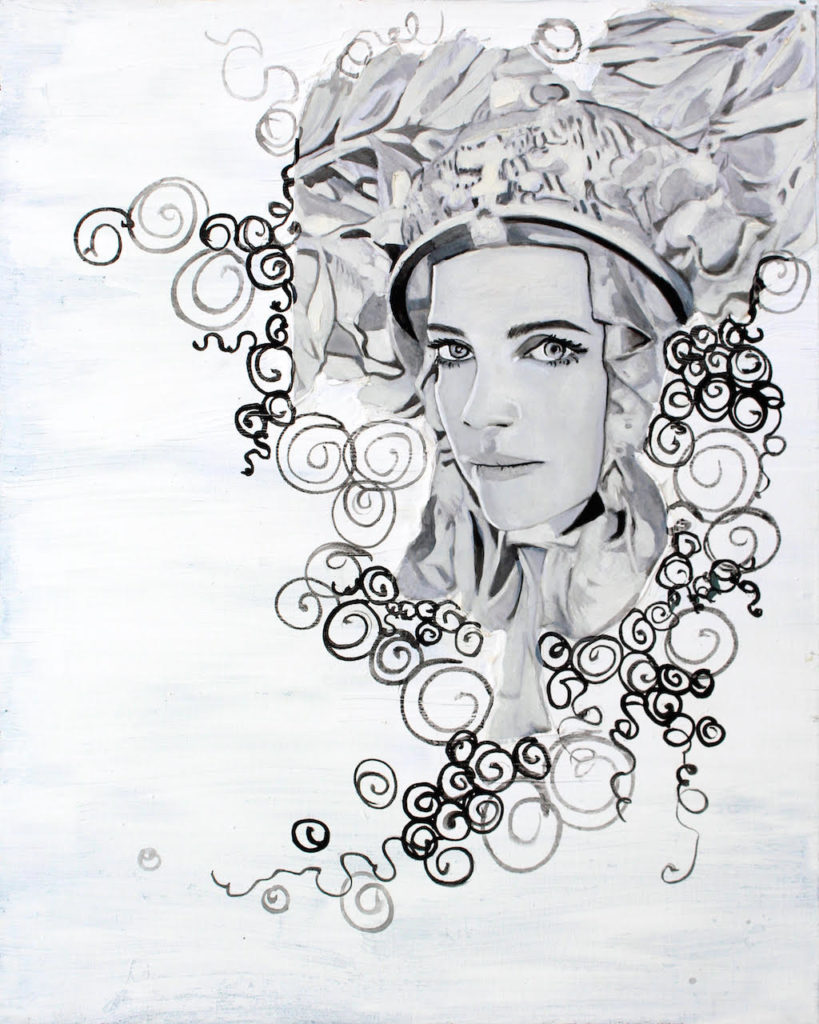
When artist Kate Kelton sets out to do something – she does it. She, like her latest series, is Indomitable. Kelton’s astonishingly lovely and glowing images of women are created to tackle an important subject with grace and power: “I try to uplift and elevate Silence-Breakers, Patriarchy-Smashers, Truth-Tellers, Survivor-Hero and Sheroes to the highest reaches of architectural strata. Apotheosis through a reclaimed, reapplied Art Nouveau. Sampling my own lineage, I transform a historical body of work, itself a thing of lasting beauty; exchanging granite for graphite, plaster for paint,” she says. “To date, 105 silence-breakers accused Harvey Weinstein of gross sexual misconduct, 60 came forward about Bill Cosby. Over 200 are rumored to be coalescing against Donald Trump, with 24 having come forward already. More than 400 spoke out within the first 48 hours following the publication of director James Toback’s profile. One can’t even imagine the number for Jeffrey Epstein. With Harvey Weinstein’s trial finally coming up… I want to focus on weaving my protection spell over the subjects of my work, because I’m a hella superstitious astrology aficionado.”

She is also a riveting artist; her subjects leap at viewers, deified, as she puts it with “headdresses, helmets and crowns from my ancestors’ constructs,” as she creates she also works to “weave an unbreakable spell of protection. Could my paintings inadvertently put Harvey in jail? With a pandemic, global 1% conviction rate for rapists who even make it to the courts… it certainly couldn’t hurt to try. I suppose it’s a little like that Bible bit from Isaiah, but far less evangelical since I was raised agnostically. Even under heavy resistance and surrounded of adversaries, no weapon that is formed against me, shall prosper.”

Kelton is also donating a portion of the proceeds from the show to Citizen Lab, located in her home town of Toronto, an organization that studies how surveillance and content-filtering impact the security of the Internet, and in so doing, pose a threat to human rights. In regard to her subjects, she notes that so many have been cyberstalked, tracked, hacked and gas-lit for speaking their truth.
But in her work, the women she depicts are filled with light, life, and fierceness. Her recent paintings include E Jean Carroll, Lili Bernard, Andrea Constand, Victoria Valentino, James Safechuck, Drew Dixon, Louisette Geiss, Kadian Noble, Caitlin Dulany, Jessica Bishop, Lou Godbold, Lisa Christie, Johnathon Schaech, Tasha Dixon, Jill Harth, Lisa Christie, Reverend Vera Lauren, Eden Tiril, Alice Evans, Erika Rosenbaum, Stacey Pinkerton, Molly Maeve, Ani Easton Baker, Sand Van Roy, Natasha Stoynoff, Melissa Schuman, Samantha Holvey, Lauren O’Connor, Mhairi Steenbock, Lucia Evans, Melissa Thompson, Lizzette Martinez, Lisette Anthon,y and Jasmine Lobe.

She terms her current work both a continuation and a departure from her previous art. As to her subjects, she notes that last year she painted famous actors almost exclusively while this year she has included lesser known survivors of abuse atrocities, those who have “been on the very frontline” of bringing down predators. “Uplifting these truth-tellers is triggering, arduous, and begging for trolling from fixers’ bot armies on social media. Yet it’s more fulfilling then anything I’ve ever done. When I began painting these warriors, it was because I too had just been effectively ousted from the acting industry.”
She adds “The women I depicted last year had established careers, most with years of work under their belts. The framed, high gloss, full color, rich and finished quality to my Sentry series is something I wanted to contrast this year while working on paintings of many whose lives and careers were derailed so early they never got the traction to elevate, to become ‘household names.’” The limited palette in which she works serves as a metaphor for the limitations her subjects must surmount to express their messages when careers and platforms were stolen, she attests.

Her moving, lush images, and the almost frenetic pace at which she creates these visually and spiritually glowing works are inspired in part by a story “about a woman who received her poetry on the wind and allowed it to flow through her from the top of her head to the tips of her fingers,” according to Kelton.

She describes her use of gorgeous headdresses with faces as a combination in the “hope the Gestalt elevates the individual pieces into a third and separate whole, something alchemically different.” She credits the subjects for selfies as well as photographers such as Freddie B, Rich Klein, Naomi Kaltman, Dawn Quiacos, Skip Gue, Lou Noble, Sabrina Reeves, Matt Sayles, Dana Patrick, Brooks Freehill, and Ernst Tramposch, who provided images for her to work from.

Her palette has its own poetry. “When paint becomes swampy and muddled from too many changed minds and crazed brushstrokes; when the lines lose their vibrancy buried under the weight of simply too much frenetic gesticulating, OCD levels of surface decoration on my part generally mean color is where I have to place emphasis on simplicity anyway. The eye already moves about so much over the surface of my pieces, that a full rainbow spectrum feels as garish and overwrought to me as it must have to the initial critics of Fauvism, back in the day.”
Kelton says she also clings to the natural color schemes her mother uses in her own painting and assemblage, and uses patient applications of thinly layered glaze in her work, as did one of her father’s favorite artists, Rothko.

“I’m additionally experimenting with the textural differences between matte and glossy surfaces. It’s expanded my grey scale considerably, working from Stuart Stemple’s Blackest Black to various silvers and iridescent whites that exceed even titanium white, given the right light.”
She stresses that she refuses to “lose a painting’s ability to alter through time by reflecting changing lighting conditions.” Her passion for mutable light is both geographically and seasonally driven. “Have you ever noticed the quality of light in different cities? Blue-ish white light bounces from Lake Ontario over most of Toronto, while smog’s red haze hyper-saturates every stunner sunset in LA.”
More on Kelton’s palette: “Underpaintings have always fascinated me. Desaturated, black and white work that emphasizes the importance of Notan, a Japanese design concept involving the play and placement of light and dark elements as they are placed next to the other.” She adds “The only color I’m adding alongside the various metallics, grays and neutral browns I’m working with this year, is green. Partly because it represents lush growth – in plant life as well as one’s finances, something all Silence Breakers could stand to enjoy after all the illegal punitive retaliation – but also because seeing how subtle an infinite amount of different greens naturally appear in the undertones of the gold, or in copper’s oxidization, is unendingly inspiring to me.”

The visceral quality of her work goes far beyond color, and pay tribute to Kelton’s ancestors. “Listen, you’d rip off your ancestors too if you suddenly found out they’d designed the Central Train Station in Prague and hired incredible sculptors to blow people’s minds… just because. There are dozens of arches on either side of the train station’s main entrance. Each one is crowned by a face wearing a helmet, crown, or headdress of some kind. They represent, presumably, the people and places connected by those trains.”
Just as connected are her recent series of works: With Joe’s Train Station, she paid homage to her great grandfather, Josef Fanta, the architect, engineer, painter and sculptor behind that station. “My father’s family fled Prague when Czechoslovakia was handed over to the Russians after the war. The real repercussions of politics – something that many Americans only seem to be waking up to now – were always a tangible part of my life growing up. Metaphorically rebuilding my great grandfather’s train station became as soothing as any balm or salve for the times.” That exhibition was followed by Artstar, in which portraits of artists “were now cloaked in the garb of statues my great grandfather tasked Ladislav Šaloun with sculpting onto his train station. The work presented a tactility against the digitized space, and represented a taking, an acquisition of power back from the tastemakers.” Next came Sentry, marking the #metoo movement, and combining “the faces of brave silence breakers with photos of the statues’ headpieces, in situ. I asked the incredibly talented artist Steve Seleska to add a super high gloss glaze to the pieces, to bring out the rich reds, blues and browns.”

All of Kelton’s work has a dream-like quality despite its realism. “Working to combine the stone statuary with living, breathing flesh is the trick for me now. The spaces in between fall into an abstract category bridging the gap, hopefully suspending the viewers’ disbelief long enough to be enchanted by the whole; the Gestalt of it.” She describes the headdresses worn by her subjects as “heavy crowns to bear — sometimes showing up in gilded hands holding up heads hung low. These powerful Silence Breakers have been doing the work of moving the dial thanklessly and tirelessly for years now,” she explains.

The inspiration for and genesis of Indomitable comes from those who, Kelton says, “have spoken up at great personal cost to inspire the #metoo wave that’s swept the world…To champion them and their work seems such a small token of gratitude, since they risked everything to make this industry safer.”
Kelton is working on plans to tour the series, starting with the Arkansas Coalition Against Sexual Assault’s Masquerade Ball on May 2, 2020.
- Genie Davis; Photos provided by Kate Kelton


